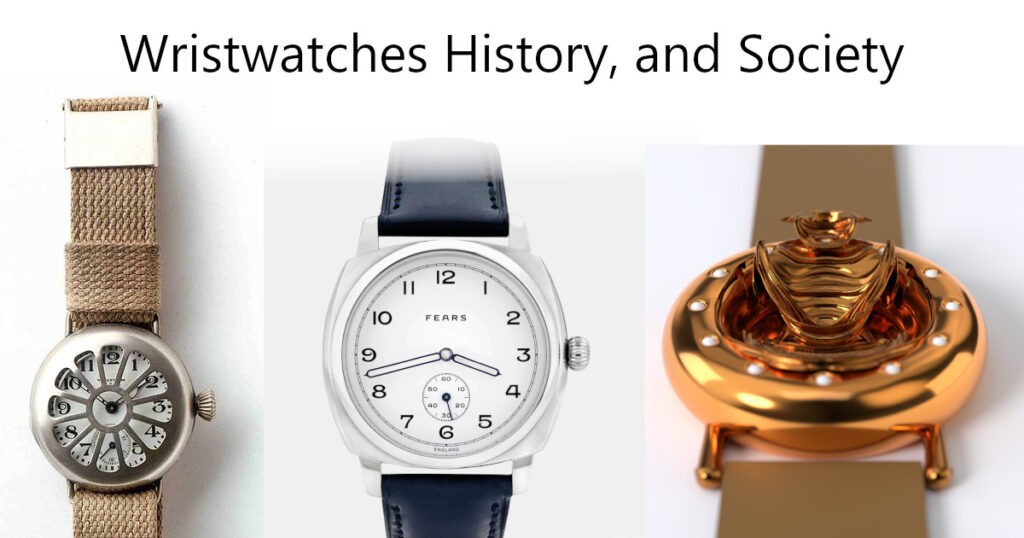
The watch on the right is our Fractal Emergence.
Sections of this article:
- Wristwatches History: The Early Years
- The Evolving Importance Of Timekeeping In Society
- The 19th Century: A Pivotal Era In The Evolution Of Wristwatches And Their Societal Significance
- Timekeeping: Importance And Standardization
- A Pocketwatch On Your Wrist
- Men’s Wristwatches Gain Popularity
- The Quartz Crisis
- Digital Timekeeping
- Smartphones and Smartwatches
- Wristwatches Today: Traditions, Innovations, And Society
Introduction
This article looks at wristwatches: history and development, and how this fascinating evolution relates to the societies which shaped, and were shaped by, the continual progress of horology through history to the present day.
Wristwatches History: The Early Years
Initially, wristwatches were primarily designed for women as decorative accessories, and were usually highly inaccurate. They related more to jewellery than the much more practical pocket watches used by men at the time.
In 1571 Elizabeth I of England received a wristwatch, which was described as an “armed watch”, from Robert Dudley. The oldest surviving wristwatch, which was described as a “bracelet watch” was made in 1806 and given to Joséphine de Beauharnais. In 1810, the watch-maker Abraham-Louis Breguet made a wristwatch for the Queen of Naples. And one of the earliest examples of Swiss wristwatches is the Patek Philippe “bracelet watch” created in 1868 for Countess Koscowicz of Hungary.
Women in this age were expected not to know what time it was.
A minute hand was added to the face of pocket watches around 1680 in Britain and around 1700 in France, because increases in accuracy made a minute hand realistic. Here is a drawing of a watch from 1737:
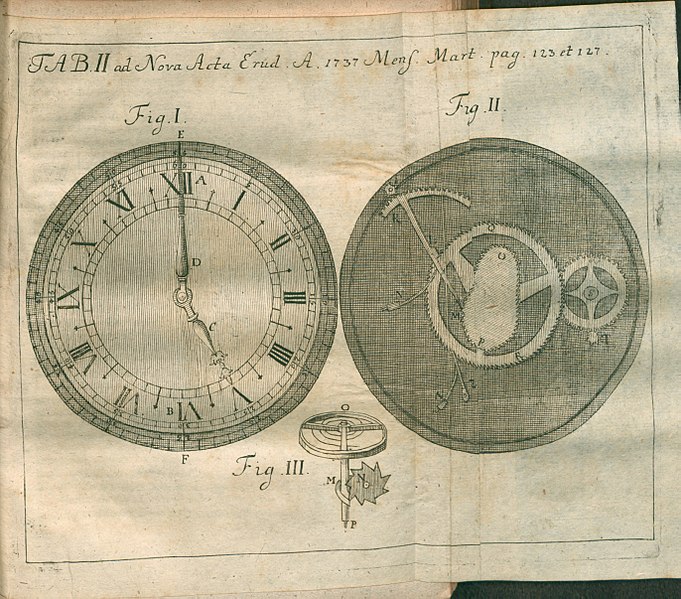
While at this time, while wristwatches were designed just for decoration, portable clocks and pocket-watches were increasingly vital for long-distance navigation and for success in naval battles because the more accurate the timekeeping, the more precise the measurement of longitude. This was so vital for societies at the time that the British government offered prizes of the equivalent of over 2 million dollars, for improved timekeeping. John Harrison’s marine chronometer, created in response to that prize, became one of the most famous timepieces ever made, which is an important part of how timekeeping became so significant in societies . . .
The Evolving Importance Of Timekeeping In Society.
When most people lived an agrarian life, where you worked directly for your survival, you woke and started work at first light because if you didn’t, you and your family starved. There was no concept of fitting in with other people’s idea of what time you should be doing things.
The advent of mechanical clocks in medieval Europe marked a transformative era in timekeeping. Town squares boasted prominent clock towers, signalling the importance of synchronized communal activities. Monasteries and churches played a pivotal role in maintaining and advancing clock technology, emphasizing the significance of time in religious practices and daily routines. An examples of this is the beautiful Prague Astronomical Clock (made in 1410), the most famous clock from the Medieval period, shown below:
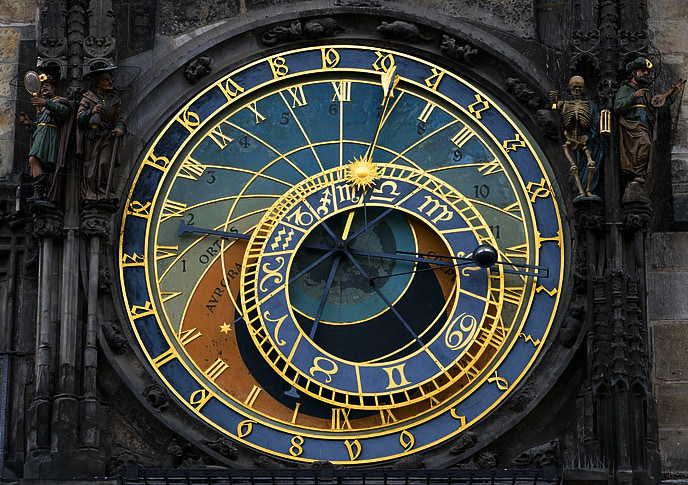
The 17th century witnessed the introduction of the balance spring by Dutch scientist Christiaan Huygens, a breakthrough that significantly enhanced accuracy. The drawing below is of one of his first balance springs:
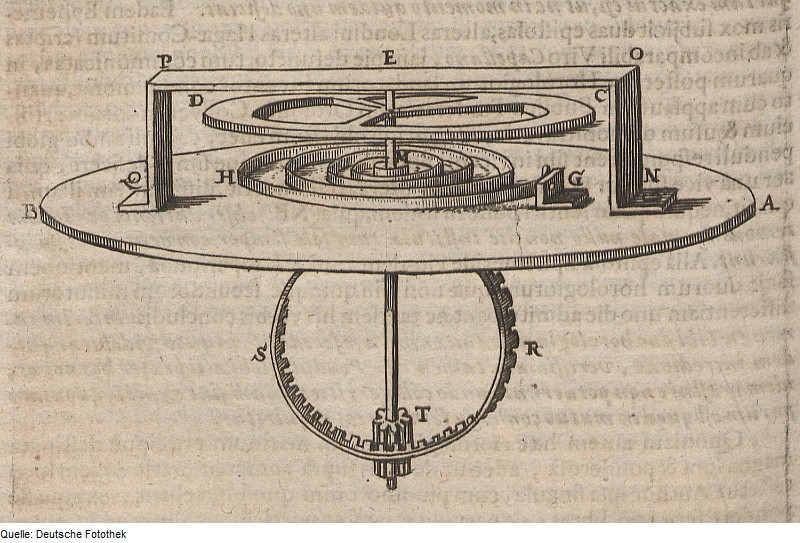
As maritime exploration expanded, precise timekeeping became crucial for long-distance navigation as well as naval battles, as I mentioned in the last section of this article.
The 18th century witnessed a significant evolution in timepieces, reflecting the changing dynamics of society. Early in the century, ornate and intricate clock and pocket watch mechanisms were status symbols reserved for the aristocracy, so being on time to an event was an indication of high status.. As craftsmanship improved, there was a shift towards smaller, more portable watches, marking a transition from clocks dominating public spaces to personal timekeeping devices.
The growing importance of trade, exploration, and scientific endeavours during the 18th century spurred advancements in horology. Accurate timekeeping became increasingly crucial for navigation, commerce, and coordinating activities. This era saw the widespread adoption of the balance wheel in watches, enhancing precision. The relationship between timepieces and society became further intertwined, as punctuality and organization gained prominence in both public and private spheres. The 18th century laid the foundation for timepieces as essential tools in navigating the complexities of an evolving society.
In the 18th-century, Monday mornings got off to a slow start, with gossip about the weekend. As the industrial revolution got under way, it was a challenge for the new entrepreneurs to persuade their workers to be on time. In the well-known English potteries of Josiah Wedgwood, the clerk of the manufactory had a job description which included noting how late some workers arrived.
The 19th Century: A Pivotal Era In The Evolution Of Wristwatches And Their Societal Significance
Most people in the newly developing world lived without clocks until well into the 19th century. Farmers, fishermen and craftspeople rose with the sun and went about their daily lives. When the sun set they lit lamps and candles then went to sleep after their evening chores were complete, rarely thinking about hours and minutes at all.
The 19th century witnessed a profound transformation in timekeeping technology, marking a pivotal era in the evolution of timepieces and their societal significance. The century began with the dominance of traditional mechanical clocks and watches, often confined to the homes of the affluent elite. However, as the century progressed, advancements in craftsmanship and industrialization led to the democratization of timepieces, making them more accessible to the broader population.
The pocket watch gained popularity during this century, as a portable and stylish accessory. This allowed individuals to carry time with them, transforming the way people organized their daily lives. The image below shows an Arcadia pocket watch from 1859:
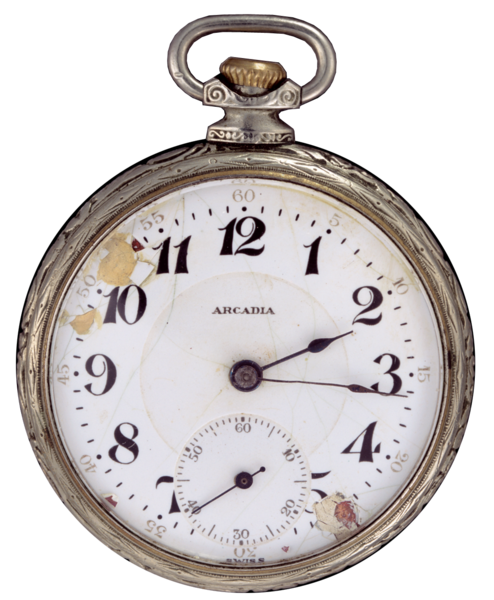
The industrial revolution in the 19th century accelerated the pace of life, necessitating standardized timekeeping for efficient coordination in factories and transportation networks. Railways, in particular, essential components of the 19th-century transportation revolution, relied heavily on accurate timekeeping for scheduling and coordination, further emphasizing the importance of reliable timepieces. They relied on synchronized schedules, leading to the establishment of standardized time zones. Before this period, different towns would not synchronize their timekeeping with each other, because there was no real need to do so.
The first mass-produced watches marked a pivotal moment in horological history, democratizing access to timekeeping and transforming watches from luxury items to practical necessities for a broader audience. This breakthrough occurred in the 19th century, driven by technological advancements and the industrial revolution.
The British Watch Company modernized clock manufacture with mass-production techniques and the application of duplicating tools and machinery in 1843. Another notable pioneer was Aaron Lufkin Dennison, an American watchmaker who, in the 1850s, established the Waltham Watch Company in Massachusetts. The company introduced interchangeable parts and an assembly line approach to their watchmaking, streamlining production and reducing costs. The Waltham Model 57, launched in 1857, was one of the first examples of a mass-produced watch.
This approach was further developed by Swiss watchmaker Georges Favre-Jacot, who founded the Zenith watch company in 1865. Favre-Jacot’s use of standardized components and the division of labour in manufacturing contributed to the mass production of reliable and affordable watches.
Timekeeping: Importance And Standardization.
The impact of mass production on watches extended beyond accessibility; it also led to the standardization of timekeeping. The widespread availability of accurate timepieces facilitated coordination in various sectors, from transportation schedules to industrial processes. Mass-produced watches played a crucial role in shaping modern society’s reliance on precise and synchronized timekeeping.
The term “Stemwinder,” first used in 1875 related to the superiority of the stem-winding watch over the older key-wound watches, and came to be used to refer to something that is the best of its kind.
Sir Sandford Fleming’s proposal for a worldwide 24-hour time system at the International Meridian Conference in 1884 laid the foundation for the global timekeeping framework we use today.
The accuracy of watches was of great importance to societies at that time. For example, a 4-minute error of a watch carried by an engineer on a train caused the “Great Kipton Train Wreck” which was a collision between two trains in Kipton, Ohio in 1891 (for details see this article “The Origin of the Railroad Watch“). The engineers on both trains and nine train crew died. This event led to the standardization of watch specifications for railroad use. The image below is of a Railroad Grade Waltham watch, circa 1913:
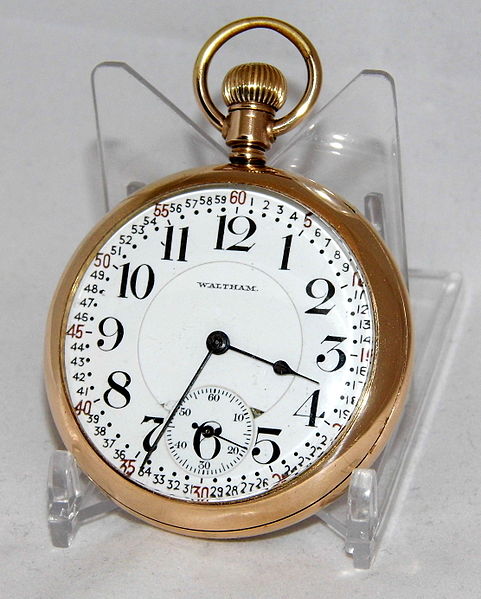
Mr. Ball devised a now-famous set of standards for an acceptable railway pocket watch, which included the watch having a minimum of 17 jewels, a double roller, steel escape wheel, micrometric regulator and grade on the back plate. And that it must keep time accurately to plus or minus 30 seconds a week.
The Industrial Revolution played a pivotal role in the evolution of timekeeping. Precision engineering and mass production techniques enabled the creation of more affordable and accurate clocks and watches. This accessibility fostered a sense of punctuality and efficiency in society, aligning with the increasingly regimented and time-conscious nature of the era.
Moreover, the 19th century marked the transition from mechanical to quartz timekeeping towards the end of the century, foreshadowing further electronic advancements in the 20th century. The evolution of timepieces in the 19th century reflects not only technological progress but also the changing values and demands of a society on the brink of modernization. Timepieces became more than mere instruments; they became symbols of societal progress and the relentless march towards precision and efficiency.
A Pocketwatch On Your Wrist
These were the first wristwatches for men, basically a standard pocket watch held onto the wrist with a leather strap for more convenient use. They were issued to officers at first, then for all soldiers by the end of the war. There were plenty of advertisements of wristwatches for use in trenches.
During the First Boer War of 1880–1881 the importance of coordinating troop movements and synchronizing attacks against highly mobile Boer insurgents became paramount, and the use of wristwatches subsequently became widespread among the officer class. The company Mappin & Webb began production of their successful “campaign watch” for soldiers during the campaign in the Sudan in 1898 and accelerated production for the Second Boer War of 1899–1902 a few years later. Below is an image of one of their advertisements from 1915:
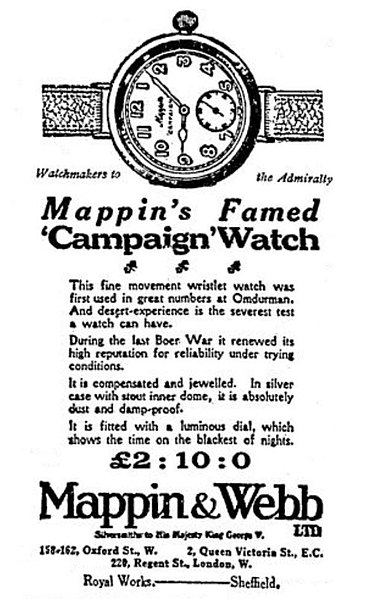
In continental Europe, from about 1880, Girard-Perregaux and other Swiss watchmakers began supplying German naval officers with wristwatches.
At the beginning of the 20th century, the steam whistles of factories were a common sound in most parts of the industrialized world. In the 1890’s the Bundy Manufacturing Co., located in Binghamton, New York, developed time clocks that stamped timecards to time the arrival and departure of each worker, In 1911, their company merged with two other companies to form the Computing-Tabulating-Recording Company, which was a forerunner of IBM (International Business Machines).
The turning point came during World War I when soldiers on the battlefield began needing precise timing for military manoeuvres like the creeping barrage, and found it cumbersome to use pocket watches while engaged in combat. The need for a more accessible timekeeping solution led to the widespread adoption of wristwatches. These timepieces were strapped to the wrist, providing convenience and efficiency in checking the time during intense situations. The war played a pivotal role in reshaping the perception of wristwatches from mere accessories to essential tools for practicality and convenience.
The War Office began issuing wristwatches to combatants from 1917. Below is an example of a wristwatch worn during World War 1, made by Waltham:
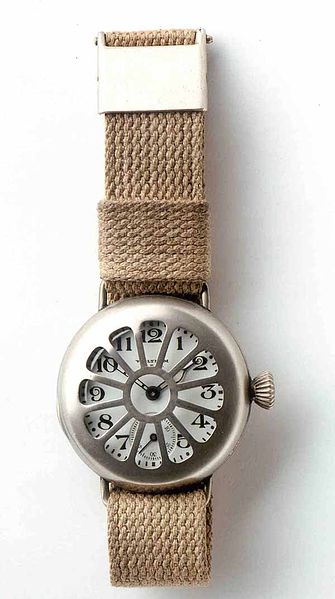
Returning soldiers popularized the use of wristwatches in civilian life. The shift was not only practical but also a fashion statement, breaking away from the traditional association of wristwatches as feminine accessories. In the post-war era, prominent watchmakers recognized this shift in demand and began producing wristwatches tailored for men, although pocket-watches continued to be used for railroads until some time later.
Men’s Wristwatches Gain Popularity
By 1930, the wristwatch vastly exceeded the pocket watch in market share by a ratio of fifty to one.
Returning World War I veterans brought the habit of wearing wristwatches back to civilian life, contributing to the mainstream acceptance by men of this once-feminine accessory. The practicality and functionality of wristwatches, coupled with their newfound association with the bravery and camaraderie of soldiers, appealed to a broader male audience. This shift in perception catalysed a fashion movement, and wristwatches evolved from being a practical wartime necessity to a symbol of masculinity and modernity in the post-World War I era. The iconic styles of that time, including the enduring influence of watches like the Cartier Tank and Rolex Oyster, continue to shape men’s wristwatch fashion today.
Looking back slightly before the war, in 1904 practicalities for aviators and drivers shaped the typical format of the wristwatch after that time. One of the iconic examples of this transition is the Cartier Santos, introduced in 1904. Initially designed as a pilot’s watch for Alberto Santos-Dumont, it featured a square case and a leather strap, setting a trend for men’s wristwatches. This departure from the circular pocket watch design marked a bold aesthetic shift that resonated with the evolving preferences of the time:
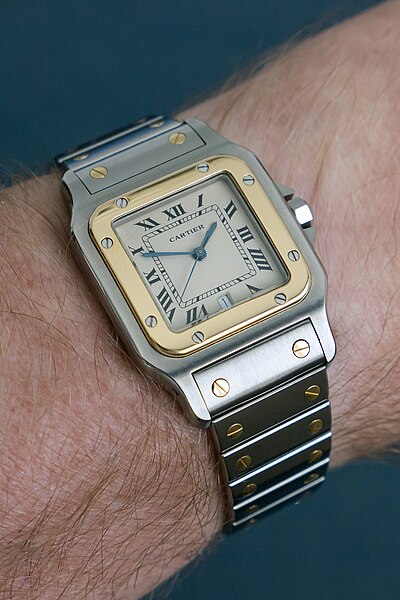
Many aspects of the design of the Cartier Santos, a true example of revolutionary watch design, have been the basis for most watch designs since that time.
The technological advancements of the early 20th century further facilitated the transition. The development of self-winding mechanisms and smaller, more reliable movements made it feasible to create wristwatches that were accurate and practical. Brands like Rolex (such as the example below from 1954), Omega, and Patek Philippe embraced the shift, producing high-quality wristwatches that combined precision with elegance.
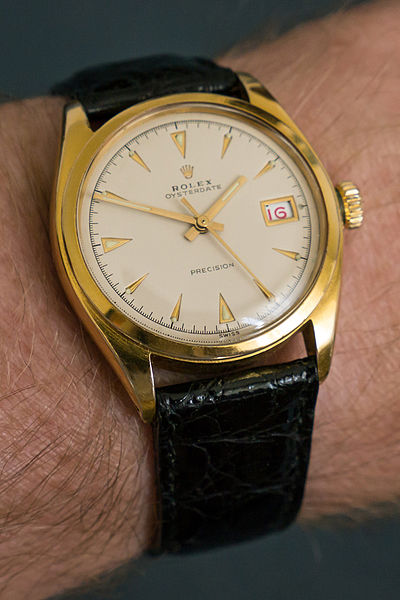
By the mid-20th century, wristwatches had firmly established themselves as the standard timekeeping devices for both men and women. The emphasis on style and design continued to evolve, with the introduction of new materials, innovative complications, and iconic models that became symbols of status and taste.
The 1950s produced the first electric watches. Some used a tuning-fork resonator to improve accuracy.
The 20th century witnessed the rise of electronic timekeeping with the popularity of quartz clocks and wristwatches. Later, the atomic clock, employing the vibrations of atoms to measure time, set new standards of accuracy, essential for scientific advancement and technological development. As societies became increasingly globalized, precision in timekeeping became essential for international communication, trade, and scientific endeavours.
The convenience and versatility of wristwatches led to their integration into various aspects of modern life. The advent of electronic and quartz movements in the latter half of the century further enhanced accuracy and affordability, making wristwatches accessible to a broader audience.
The Quartz Crisis
The first quartz watch, released in 1969, was the Seiko Astron:
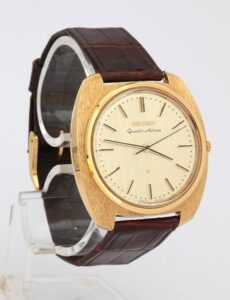
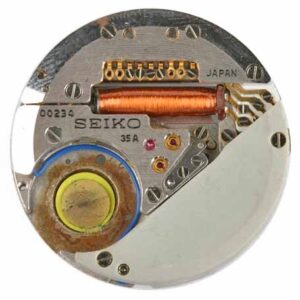
Quartz watches became so popular in just over a decade that from the 1980’s there were more quartz watches than mechanical ones.
The Quartz Crisis, also known as the Quartz Revolution, was a transformative period in the watchmaking industry that unfolded during the latter half of the 20th century. It was marked by the widespread adoption of quartz crystal technology, a shift that fundamentally altered the landscape of timekeeping and posed a significant challenge to traditional mechanical watches.
The origins of the Quartz Crisis can be traced back to the development of the quartz crystal resonator in the late 1920s. However, it wasn’t until the 1960s and 1970s that this technology became commercially viable for wristwatches. The introduction of the Seiko Astron in 1969, the world’s first quartz wristwatch, marked a pivotal moment. The Astron boasted unprecedented accuracy, deviating only a few seconds per month, a stark contrast to the mechanical watches that typically deviated several seconds per day.
The quartz crystal, when subjected to an electric current, vibrates at a precise frequency, serving as an accurate timekeeping regulator. This breakthrough in technology allowed for the creation of electronic quartz movements that were not only more accurate but also more cost-effective to produce than traditional mechanical movements.
Swiss watchmakers, who had long dominated the high-end mechanical watch market, initially dismissed quartz technology as a passing fad. However, the affordability and accuracy of quartz watches quickly captured consumer interest. Japanese manufacturers like Seiko flooded the market with quartz timepieces, challenging the Swiss monopoly on watchmaking.
The Quartz Crisis reached its zenith in the 1970s and early 1980s, resulting in a severe economic downturn for the Swiss watch industry. Traditional Swiss watchmakers struggled to adapt to the new technological landscape, and many iconic companies faced bankruptcy or closure. The term “Quartz Crisis” itself reflects the turmoil that ensued, as the Swiss watch industry grappled with the existential threat posed by quartz technology.
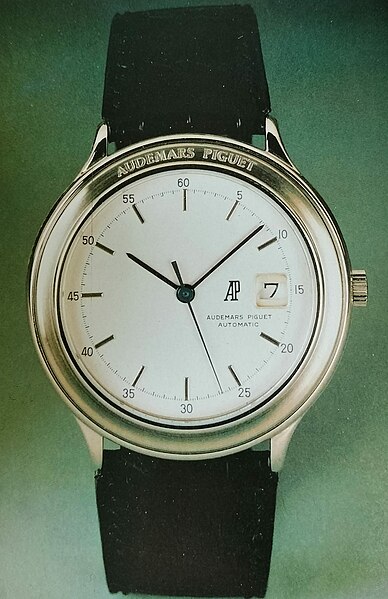
However, the crisis also prompted innovation within Switzerland. High-end Swiss watchmakers, such as Patek Philippe and Audemars Piguet (above), refocused their efforts on producing exquisite mechanical watches that emphasized craftsmanship, heritage, and exclusivity. This shift toward luxury and heritage laid the foundation for the Swiss watch industry’s resurgence.
For another perspective on the quartz crisis, see this section of another of our article about an industry in peril.
The Quartz Crisis, while a challenging period for traditional watchmaking, ultimately led to a renaissance in Swiss horology. The industry learned valuable lessons about adaptation, innovation, and the importance of preserving the artistry of mechanical watchmaking. Swiss watches, especially those with mechanical movements, regained their status as symbols of craftsmanship, precision, and luxury, reflecting a significant polarization between cheap functional watches and expensive beautiful ones, which continues to affect the watchmaking industry to this day.
Digital Timekeeping
Digital watches have played a significant role in mirroring and influencing societal changes since their introduction in the 1970s:
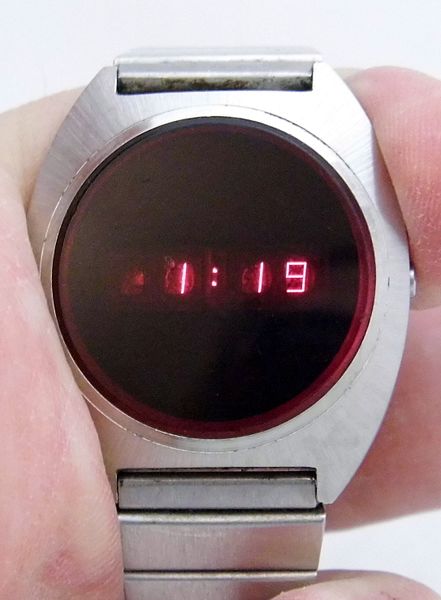
Beyond mere timekeeping devices, these watches have been emblematic of the rapid technological advancements and shifting cultural dynamics of the late 20th century.
The rise of digital watches coincided with a burgeoning fascination with technology and a move towards a more fast-paced, efficient lifestyle. With bold numeric displays and features like alarms and chronographs, digital watches embodied the modernity and convenience sought after in an era of rapid urbanization and globalization.
In the 1980s, the digital watch market expanded as brands like Casio introduced affordable, feature-rich models, such as this model, first released in 1989:
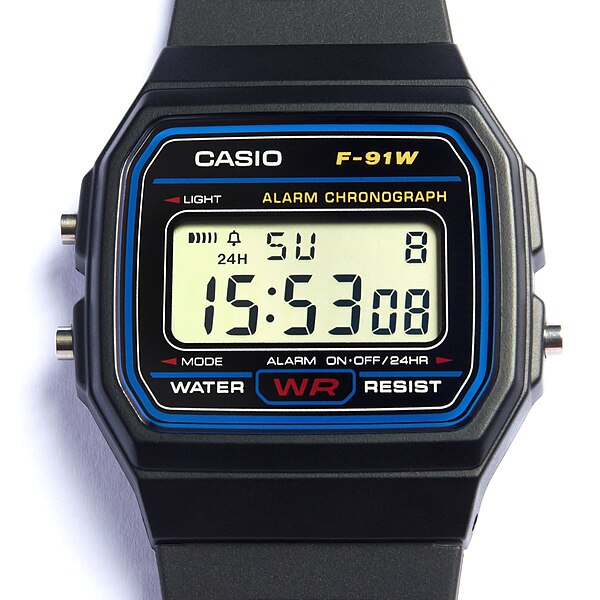
This democratization of technology made digital watches accessible to a broad audience, symbolizing a shift towards a more tech-savvy and interconnected society. The incorporation of calculators, calendars, and other functionalities in digital watches reflected a growing dependence on portable technology for everyday tasks.
Furthermore, digital watches became fashion statements, reflecting the casual and sporty aesthetics of the time. The vibrant colours, plastic casings, and digital displays resonated with the dynamic, youth-oriented culture of the 1980s.
The digital age ushered in unprecedented advancements in timekeeping technology. Global Positioning System (GPS) satellites only became possible due to extremely accurate timekeeping used to measure the relative times of signals from satellites synchronized to atomic clocks, and enabled precise location-based timekeeping, influencing fields ranging from navigation to financial transactions. The ubiquity of smartphones and internet-connected devices further integrated accurate timekeeping into daily life, as well as providing functions like GPS on watches such as this one by Garmin:

Today, the importance of timekeeping extends beyond mere functionality. Time is a precious resource, and the pace of modern life demands efficient time management. The evolution of timekeeping reflects not only our ability to measure the passage of time with increasing precision but also our societal values and the dynamic interplay between technological innovation and cultural evolution. Timekeeping has evolved from a practical necessity to a symbol of our interconnected, fast-paced world, shaping how we organize our lives and interact with the global community.
Smartphones and Smartwatches
Smartwatches were first introduced from 1994, but really took off in the 21st century, where they helped further blur the line between timepieces and technology. Smartwatches, descendants of digital watches, integrate with smartphones, track health metrics, and provide connectivity, embodying the contemporary emphasis on interconnectedness and data-driven living.
Smartwatches have seamlessly integrated into modern society, reflecting the digital age’s influence on our daily lives. Beyond timekeeping, these devices serve as extensions of smartphones, offering health tracking, notifications, and even communication tools. In a society driven by connectivity and efficiency, smartwatches cater to the need for instant information and seamless interaction. They exemplify the fusion of technology with daily routines, emphasizing a symbiotic relationship between wearables and the evolving dynamics of contemporary living. Smartwatches have become not just gadgets but indispensable companions in our interconnected, data-centric world.
Wristwatches Today: Traditions, Innovations, And Society
Today, wristwatches are not only functional timekeeping devices but also expressions of personal style and luxury. With everyone having the exact time on their smartphone, wristwatches no longer need to focus on timekeeping, with at least one watch (the Haldeman H9) now not having any form of time display at all.
Current trends in society, reflected in watches, include uniqueness, individuality, and personal style and taste exhibited by wearing choices from a wider than ever range of watch styles.
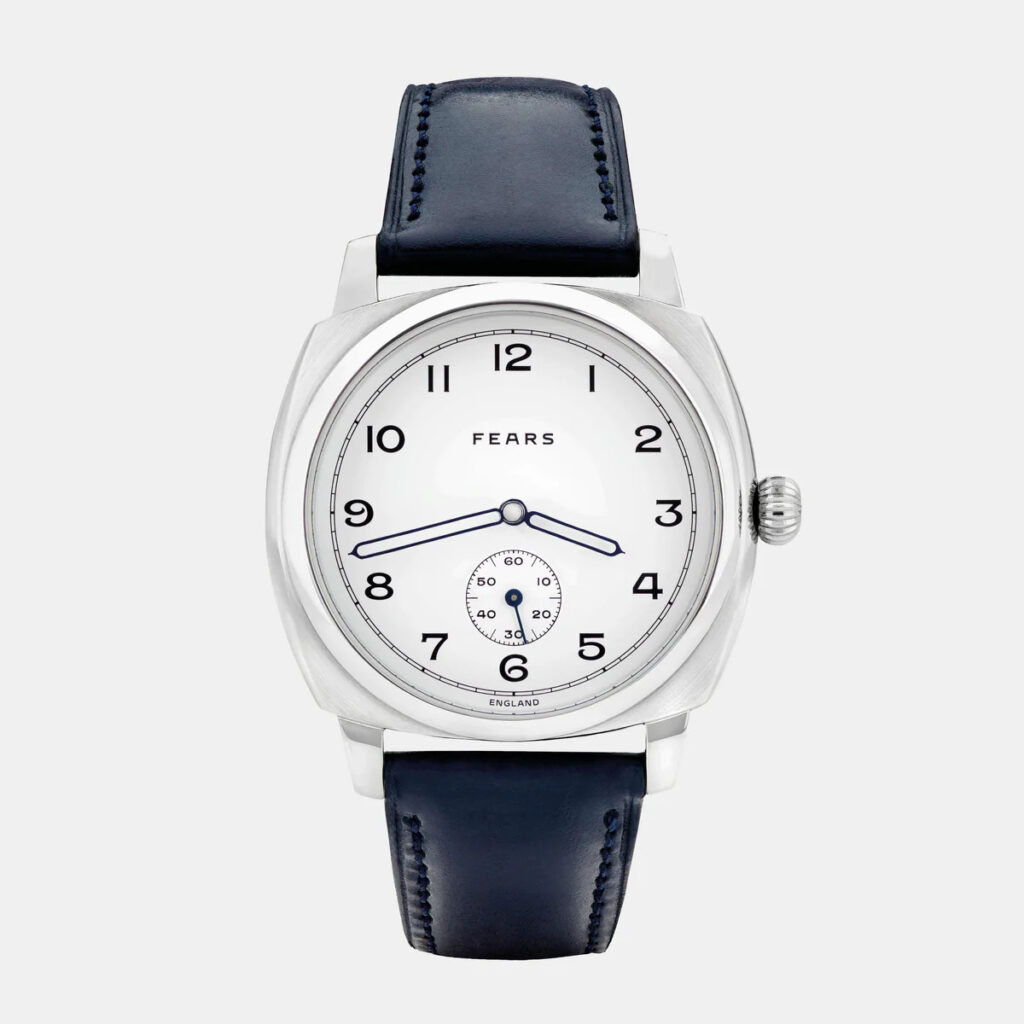
The two main aesthetic directions in watches currently are traditional references (such as the Fears Brunswick above, based on one of their watches from 1924), or innovative, creative explorations (below). Almost all of those creative explorations have so far been stretching the boundaries of either functional influences, such as engineering (for example the stunning MB&F Architect, below), whether mechanical engineering or aesthetics relating to digital time-displays, or the decorative influences of fine jewellery.
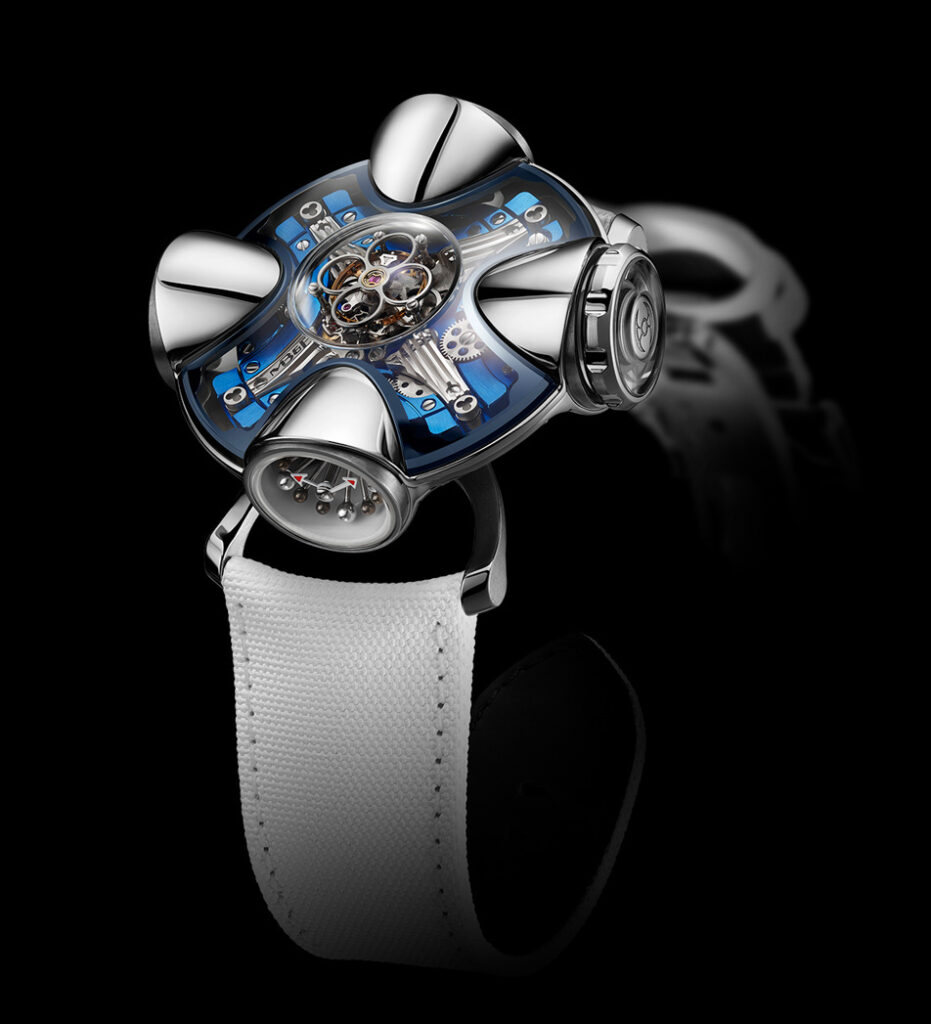
There are now some watches with a degree of influence from art jewellery, which welcomes much more complex forms and textures compared to the simple geometric forms and smooth polished surfaces of fine jewellery.
An example of this is how Holthinrichs watches proudly display the raw 3D printed texture on some parts of their watches . . . as well as the creativity shown on the dial of this one from their Liminality series shown below:
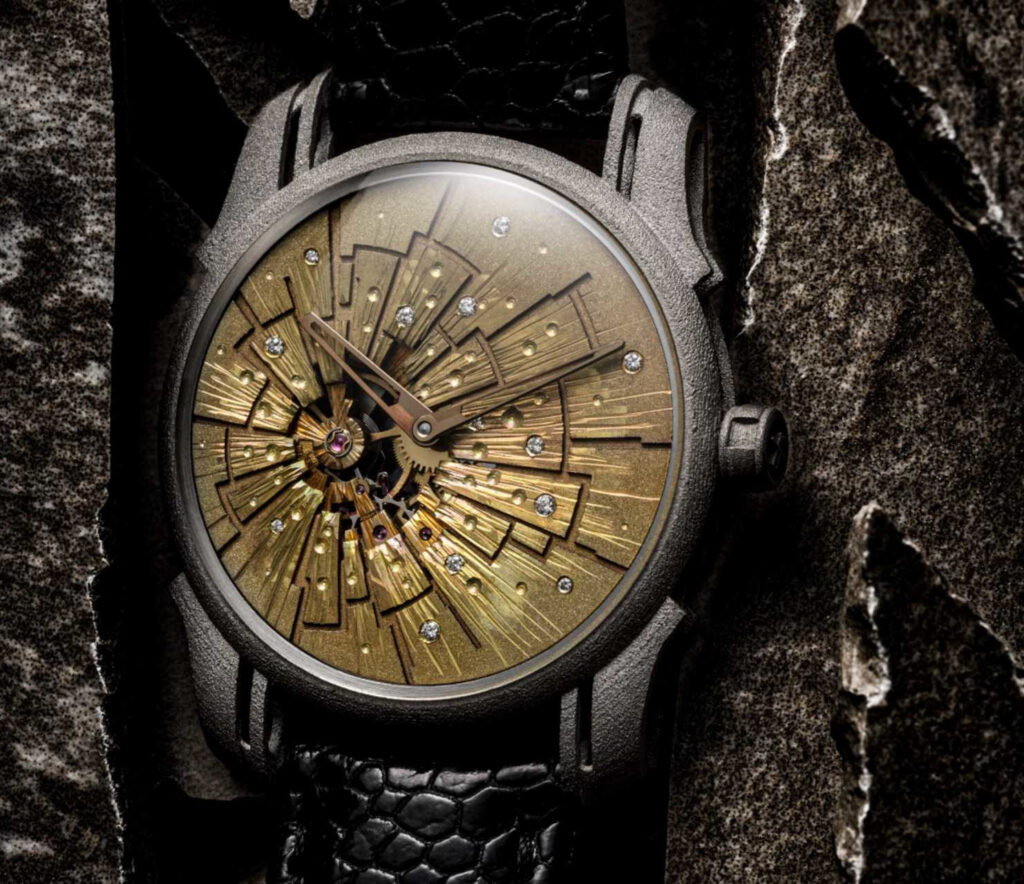
Our own brand, UnconstrainedTime, aligns with the desire for uniqueness and interesting innovations that is prevalent in today’s society.
Traditional watchmaking emerged from two primary sources: engineering and fine jewellery. While these roots have produced extraordinary timepieces, they’ve also created invisible constraints around what a watch can be. We chose a different path.
Drawing from the ancient tradition of the 12-point time ring – a concept that dates back to ancient Near East timekeeping – we stripped away conventional limitations. What remained was the simple heart of a time display that freed the rest of the watch to become a canvas for genuine artistic exploration.
Each UnconstrainedTime piece is conceived and developed as a unified artistic vision. From our world-first 3D fractal concept to interpretations of musical genres, every watch represents a unique creative journey. These aren’t merely timepieces with artistic elements – they are wearable sculptures that tell time. Each one including its creator’s signature and produced in small, considered quantities.
We hope our unusual contribution to the ongoing evolution of wristwatches, helps inspire others . . .

Don’t miss our launch. Subscribe now for notifications.
What do you think is the most interesting example of the relationship between the history of wristwatches, and society? Let us know in the comments below, or on our social media.
Author: Chris Melchior

This article was authored by Chris Melchior, founder of UnconstrainedTime and creator of the original range of wrist-worn sculptures of this unique artistic adventure.
Chris has extensive knowledge and experience of creativity, including fine art and cutting-edge contemporary music composition, and was awarded a First Class Honours Degree in fine art and music with a minor in philosophy.
Chris’s life-long artistic obsessions include organic forms and textures, abstraction, fractals, and the aesthetic essence of musical genres.
He has developed unusually deep insights into the elemental concepts underlying areas including Eastern and Western philosophies, science and technology, creativity and the arts, as well as empirical spirituality in which he is acknowledged as a leading authority.
He has a profound fascination and love for the unique and synergistically creative combination of fine art with the ancient essence of time-keeping which evolved into the UnconstrainedTime project.

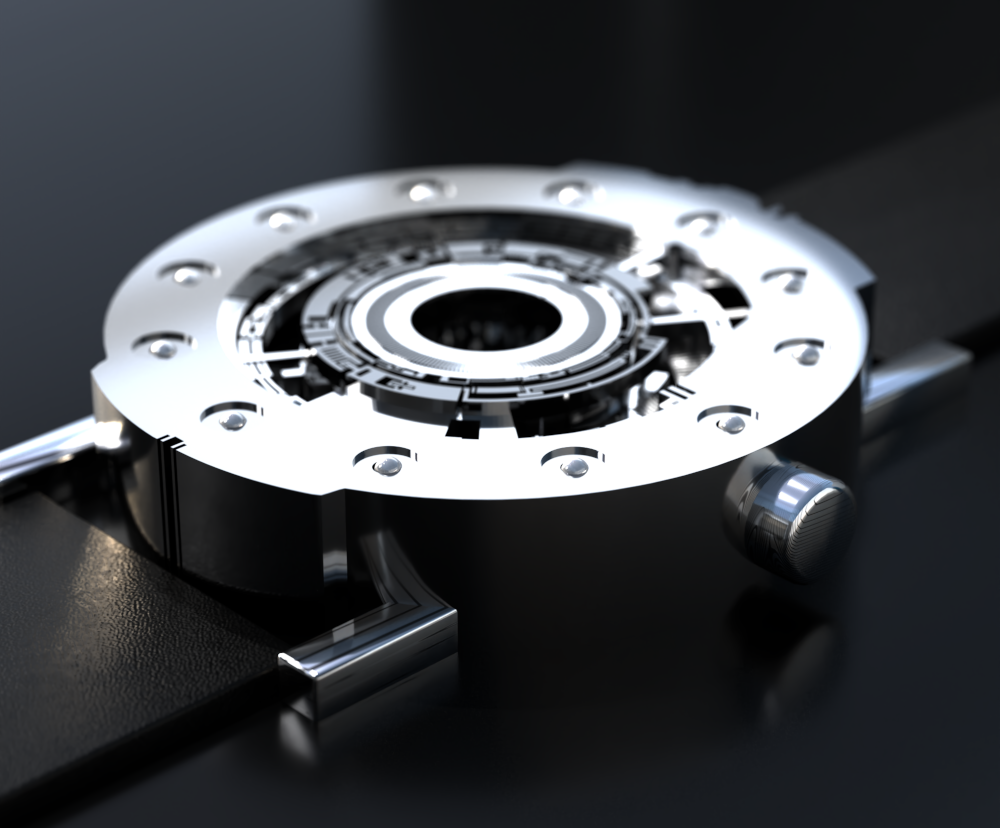

Leave a Reply